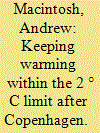| Srl | Item |
| 1 |
ID:
088051


|
|
|
|
|
| Publication |
2009.
|
| Summary/Abstract |
International aviation is growing rapidly, resulting in rising aviation greenhouse gas emissions. Concerns about the growth trajectory of the industry and emissions have led to calls for market measures such as emissions trading and carbon levies to be introduced to restrict demand and prompt innovation. This paper provides an overview of the science on aviation's contribution to climate change, analyses key trends in the industry since 1990, projects international civil aviation emissions to 2025 and analyses the emission intensity improvements that are necessary to offset rising international demand. The findings suggest international aviation carbon dioxide (CO2) emissions will increase by more than 110 per cent between 2005 and 2025 (from 416 Mt to between 876 and 1013 Mt) and that it is unlikely emissions could be stabilised at levels consistent with risk averse climate targets without restricting demand.
|
|
|
|
|
|
|
|
|
|
|
|
|
|
|
|
| 2 |
ID:
096134


|
|
|
|
|
| Publication |
2010.
|
| Summary/Abstract |
The object of the United Nations Climate Change Conference in Copenhagen in December 2009 was to reach an agreement on a new international legal architecture for addressing anthropogenic climate change post-2012. It failed in this endeavour, producing a political agreement in the form of the Copenhagen Accord. The Accord sets an ambitious goal of holding the increase in the global average surface temperature to below 2 °C. This paper describes 45 CO2-only mitigation scenarios that provide an indication of what would need to be done to stay within the 2 °C limit if the international climate negotiations stay on their current path. The results suggest that if developed countries adopt a combined target for 2020 of =20% below 1990 levels, global CO2 emissions would probably have to be reduced by =5%/yr, and possibly =10%/yr, post-2030 (after a decade transitional period) in order to keep warming to 2 °C. If aggressive abatement commitments for 2020 are not forthcoming from all the major emitting countries, the likelihood of warming being kept within the 2 °C limit is diminutive.
|
|
|
|
|
|
|
|
|
|
|
|
|
|
|
|
| 3 |
ID:
105741


|
|
|
|
|
| Publication |
2011.
|
| Summary/Abstract |
The Australian Government ran a renewable energy program in the 2000s that provided rebates to householders who acquired solar Photovoltaic (PV) energy systems. Originally called the Photovoltaic Rebate Program (PVRP), it was rebranded the Solar Homes and Communities Plan (SHCP) in November 2007. This paper evaluates both the PVRP and SHCP using measures of cost-effectiveness and fairness. It finds that the program was a major driver of a more than six-fold increase in PV generation capacity in the 2000s, albeit off a low base. In 2010, solar PV's share of the Australian electricity market was still only 0.1%. The program was also environmentally ineffective and costly, reducing emissions by 0.09 MtCO2-e/yr over the life of the rebated PV systems at an average cost of between AU$238 and AU$282/tCO2-e. In addition, the data suggest there were equity issues associated with the program, with 66% of all successful applicants residing in postal areas that were rated as medium-high or high on a Socio-economic Status (SES) scale.
|
|
|
|
|
|
|
|
|
|
|
|
|
|
|
|